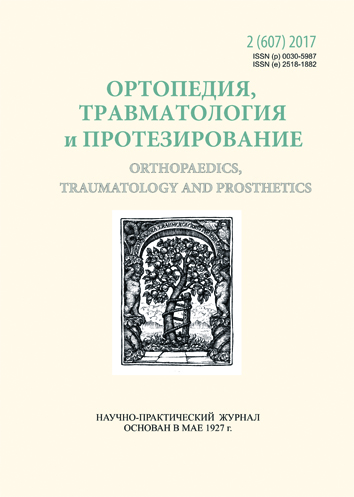Biomechanical rationale for acetubalar component selection for total hip replacement in patients with dysplastic coxarthrosis
DOI:
https://doi.org/10.15674/0030-59872017214-22Keywords:
dysplastic coxarthrosis, hip replacement, segmental acetabular defects stress-strain distribution, finite element methodAbstract
Loss of anatomical shape of acetabulum under the dysplastic hip arthrosis, presence of defects and segmental bone deficiency in this area cause problems when choosing acetabular cup design.
Objective: a comparative biomechanical evaluation of stability of pressing cup fixation and screw in terms of acetabulum segmental defect in patients with dysplastic coxarthrosis for arthroplasty.
Methods: we developed a simplified geometric hexadecimal hip model with defects of segmental ter circuit 30°, 60°, 90° and 120°; and finite-element model of «bone – cup – insert – head implant» and estimated stress-strain distribution under axial load of 1000 N.
Results: in the case of pressing cups and screw fixation, provided segmental defect up to 30°, the maximum stress in the bone bed is close to that of a healthy joint. This provides a higher quality cup screws initial stability. Given segmental defects of acetabulum 60°, 120° and 90° to reduce stress-strain distribution in bones must perform free plastic and bone screws to apply the cup. Use of pressing cups, with segmental defects over 60° is problematic.
Conclusions: both types of fixing cup endoprosthesis provide stress-strain distribution similar to that of a healthy joint. The presence of segmental defect up to 30° did not significantly affect the stiffness and strength of the pelvic bone when using screws cup. Given the short-circuit defect 30° to 60° there is the threat of cracking. If the size of the defect exceeds 60°, significantly increases the risk of destruction circuit. Cup, pressed as compared to screws, moving under a static load of 1000 H.References
- Zagorodniy NV. Total hip replacement. Basis and practice: manual. Moscow: GEOTAR Media, 2011. 704 p. (in Russian)
- Filipenko VA, Korzh NA. Total hip replacement. Kharkiv: Kollegium, 2015. 219 p. (in Russian)
- Eskelinen A, Helenius I, Remes V, Ylinen P, Tallroth K, Paavilainen T. Cementless total hip arthroplasty in patients with high congenital hip dislocation. J Bone Joint Surg Am. 2006;88(1):80–91. doi: 10.2106/JBJS.E.00037.
- Gayko GV, Pidgaetskiy VM, Sulima OM, Chkalov OV, et al. Biomechanical and mathematic grounding of prerequisites of total hip endoprosthesis’ aseptic loosening. International conference «Actual problems of total joint replacement». Abstract book. Vinnitsa, 2008. рр.23–4. (in Ukrainian)
- Tankut VA, Filipenko VA, Tankut AV, Podgayskaya OA. Mistakes and complications after primary total hip replacement, their prophylaxis and treatment. International conference «Actual problems of joint replacement». Abstract book. Kyiv, 2013. рр.93–5.
- Hailer NP, Garellick G, Karrholm J. Uncemented and cemented primary total hip arthroplasty in the Swedish Hip Arthroplasty Register. Acta Orthop Scand. 2010;81(1):34–41. doi: 10.3109/17453671003685400.
- Rogers BA, Garbedian S, Kuchinad RA, Backstein D, Safir O, Gross AE. Total hip arthroplasty for adult hip dysplasia. J Bone Joint Surg Am. 2012;94(19):1809–21. doi: 10.2106/JBJS.K.00779.
- Hartofilakidis G, Karachalios T, Georgiades G, Kourlaba G. Total hip arthroplasty in patients with high dislocation: a concise follow-up, at minimum of fifteen years, of previous reports. J Bone Joint Surg Am. 2011;93(17):1614–18. doi: 10.2106/JBJS.J.00875.
- Loskutov OО, Naumenko NE, Loskutov OE, Sinegubov DA, Gorobets DV, Furmanova KS. Estimation of the primary stability of the press-fit and screwed-in acetabular components after hip joint arthroplasty. Orthopaedics, Traumatology and Prosthetics 2017;(1):92–7. doi: 10.15674/0030-59872017192-97. (in Russian)
- Loskutov AE. Total hip replacement: monograph. Dnepropetrovsk; Lira, 2010. 344 p. (in Russian)
- Vasu R, Carter J, Harris WH. Stress distributions in the acetabular region-1 before and after total joint replacement. J Biomechanics. 1982;15(3):155–64.
- Li H, Mao Y, Oni JK, Dai K, Zhu Z. Total hip replacement for developmental dysplasia of the hip with more than 30 % lateral uncoverage of uncemented acetabular components. J Bone Joint Surg. 2013;95-B(9):1178–83. doi: 10.1302/0301-620X.95B9.31398.
Downloads
How to Cite
Issue
Section
License
Copyright (c) 2017 Oleg Loskutov

This work is licensed under a Creative Commons Attribution 4.0 International License.
The authors retain the right of authorship of their manuscript and pass the journal the right of the first publication of this article, which automatically become available from the date of publication under the terms of Creative Commons Attribution License, which allows others to freely distribute the published manuscript with mandatory linking to authors of the original research and the first publication of this one in this journal.
Authors have the right to enter into a separate supplemental agreement on the additional non-exclusive distribution of manuscript in the form in which it was published by the journal (i.e. to put work in electronic storage of an institution or publish as a part of the book) while maintaining the reference to the first publication of the manuscript in this journal.
The editorial policy of the journal allows authors and encourages manuscript accommodation online (i.e. in storage of an institution or on the personal websites) as before submission of the manuscript to the editorial office, and during its editorial processing because it contributes to productive scientific discussion and positively affects the efficiency and dynamics of the published manuscript citation (see The Effect of Open Access).














